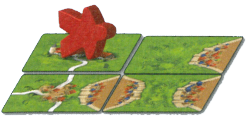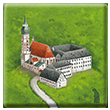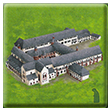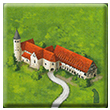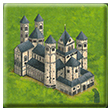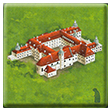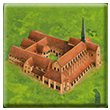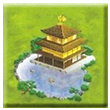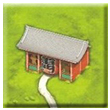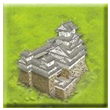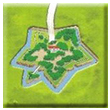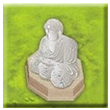Difference between revisions of "Monasteries"
m |
|||
| Line 6: | Line 6: | ||
[[File:monasteries_C2_cover.png|200px|thumb|right|Andenchs Monastery]] | [[File:monasteries_C2_cover.png|200px|thumb|right|Andenchs Monastery]] | ||
[[File:Monasteries_C1_Expansion_Watermark.png|100px|thumb|right|Monasteries of Germany | [[File:Monasteries_C1_Expansion_Watermark.png|100px|thumb|right|Monasteries of Germany symbol]] | ||
== General info and comments == <!--T:1--> | == General info and comments == <!--T:1--> | ||
| Line 16: | Line 16: | ||
Before this release, '''Japanese Buildings''', with the same rules, was released by [[Hans im Glück]] in {{Year|2016}}. It has graphics by Toshihiko Ishibashi that do not match the artwork style of the 1st edition, although the manual was based on that edition. Nevertheless it is considered a new edition mini expansion. These tiles have no expansion | Before this release, '''Japanese Buildings''', with the same rules, was released by [[Hans im Glück]] in {{Year|2016}}. It has graphics by Toshihiko Ishibashi that do not match the artwork style of the 1st edition, although the manual was based on that edition. Nevertheless it is considered a new edition mini expansion. These tiles have no expansion symbol. | ||
== Contents == <!--T:2--> | == Contents == <!--T:2--> | ||
Revision as of 18:57, 1 January 2019
General info and comments
Monasteries in Germany for the new edition was originally released by Hans Im Glück in 2018 during Essen Spiel.
This mini expansion, containing six well-known German monasteries, you'll have the possibility to score your monasteries in a renewed way. However, you'll only know at the end of the game whether you've made a profitable decision.
Before this release, Japanese Buildings, with the same rules, was released by Hans im Glück in 2016. It has graphics by Toshihiko Ishibashi that do not match the artwork style of the 1st edition, although the manual was based on that edition. Nevertheless it is considered a new edition mini expansion. These tiles have no expansion symbol.
Contents
- Monasteries in Germany: 6 new land tiles
- Japanese Buildings: 6 new land tiles
Rules
Although the Meeple can be used as an abbot in this expansion, this should not be confused with the Abbot meeple from The Abbot expansion
Preparation
Remove the “original” monastery tiles from the base game and return them to the box. [1] Mix the six new Monastery tiles in with the rest of the game tiles.
1. Placing a tile
The tiles of this expansion are placed following the basic rules of Carcassonne.
2. Placing a meeple
If a player draws one of the German Monastery tiles, he places it according to the normal rules. He then has two options when deploying a follower on the monastery:
- As a Monk: In this option, the monastery is treated like a monastery in the base game, and all the normal scoring rules remain the same; or
- As an Abbot: In this option, the follower is considered an abbot of the monastery. To emphasize this, the player stands the follower on its side to signify that the monastery will be scored differently than a cloister. The monastery scores only at the end of the game.
These two options are available whenever a meeple would be placed on the monastery: initial tile placement, wagon movement, magic portal, flier, etc.
Note that the special Monastery is only a single feature, even though it can be used two different ways. Thus, if it is occupied by a meeple, one cannot place a Phantom there, drive the wagon there, or deploy a meeple to it with a magic portal.
3a. Scoring a monk
A meeple placed on a Monastery as a monk follows the regular scoring rules of Carcassonne.
3b. Final scoring of an abbot
An abbot on a monastery is not scored until the end of the game. For his abbot, the player receives 1 point per tile present in the vertical column and horizontal row outward from the monastery. The monastery tile itself also scores 1 point. Any empty spaces in the monastery’s row or column interrupt the series of tiles that score for the monastery.
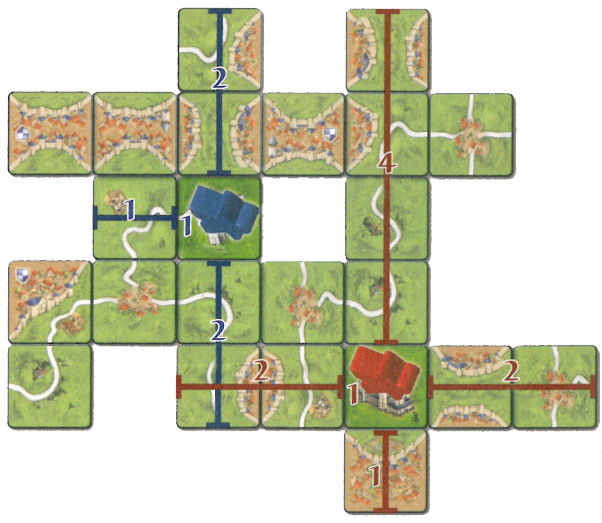
Interactions with other expansions
 Count, King And Robber
Count, King And Robber
An abbot cannot be involved in a challenge with a heretic on a shrine/cult place, as the two scoring mechanisms are entirely different (the abbot’s monastery is never completed, so the heretic would always win).
 Bridges, Castles And Bazaars
Bridges, Castles And Bazaars
Because an abbot scores only at the end of the game, and this monastery is never considered completed, a monastery with an abbot will not score points for a meeple in a castle.
 Hills and Sheep
Hills and Sheep
When using special Monasteries, the vineyard bonus is applied to the special Monastery if the follower is placed as a monk and the feature is scored as a finished cloister. However, the vineyard bonus is not applied if a follower is placed as an abbot on a Monastery, as the abbot scores only at the end of the game, when the vineyard has no effect.
 The Flying Machines
The Flying Machines
If a second meeple is placed on the special Monastery through use of the The Flying Machines, the player can choose to make the new meeple either a monk or an abbot, regardless of the identity of the first meeple there. However, if the special Monastery is already surrounded by 8 tiles, thus representing a completed monastery, the second meeple must be an abbot.
Tile distribution
Monasteries in Germany
Total Tiles: 6
Japanese Buildings
Total Tiles: 6
The Monasteries in detail
Monasteries in Germany
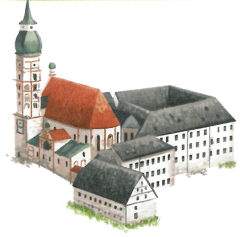 |
Andechs Monastery (Bayern) On the eastern shore of Lake Ammersee, Andechs Monastery, the oldest pilgrimage site in Bavaria, is located. It was founded in 1455 as a branch office of the Benedictine monks. The monastery is also known far beyond the borders of Bavaria for its beer. www.andechs.de |
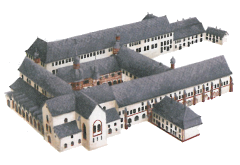 |
Eberbach Monastery (Hessen) The Eberbach Monastery is a former Cistercian abbey near Eltville. The monastery was founded in the 12th century, and with its Romanesque and early Gothic features, is one of the most important monuments in Europe. It gained worldwide fame as a filming location for the film adaptation of the novel "The Name of the Rose" by Umberto Eco. www.kloster-eberbach.de |
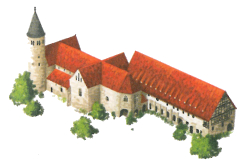 |
Lorch Monastery (Baden-Württemberg) Lorch, a former Benedictine monastery, is situated on a mountain ridge above the Rems valley, and is visible from far away. It was donated in 1102 by Duke Frederick I of Swabia and his family. The heyday of the Benedictine monastery was during the late Middle Ages. Even today, the charming monastery, complete with church, retreat, farm buildings and a garden, surrounded by a circular wall, is still completely intact, and attracts many visitors. |
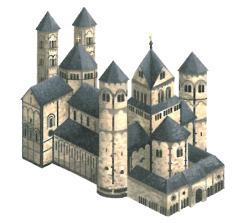 |
Maria Laach Monastery (Eifel/Rheinland-Pfalz) Founded in 1093 the Maria Laach is a high medieval monastery, located on the southwest side of Laacher Lake. A landmark of this Benedictine monastery is the 6-towered monastery church, the Laacher Munster. |
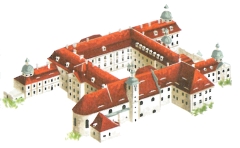 |
Marienthal Monastery (Sachsen) The monastery of St. Marienthal is the oldest convent of the Cistercian Order in Germany. It has continuously been in operation from its founding in 1234 until today. It is situated near Görlitz, on the border triangle of Germany, Poland and the Czech Republic. www.kloster-marienthal.de |
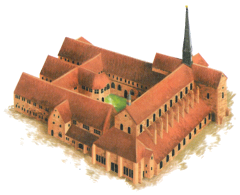 |
Maulbronn Monastery (Baden-Württemberg) The Maulbronn Monastery, a former Cistercian abbey which is now recognized as a World Heritage Site, is considered to be the most well-preserved medieval monastery north of the Alps. Founded in the 12th century, all styles and levels of development of the Romanesque period through the late Gothic period are represented here. www.kloster-maulbronn.de |
Japanese buildings
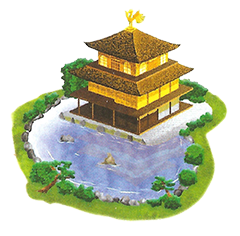 |
KINKAKUJI This Budhist temple in Kyoto is covered in gold and is one of the most popular buildings in Japan, attracting a large number of visitors anually. It was registered as a Wold Heritage Site in 1994. https://en.wikipedia.org/wiki/Kinkaku-ji |
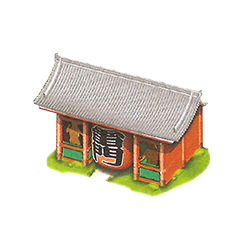 |
KAMINARIMON It is the gate of Sensoji in Tokyo. It was first built in 941 by a military commander but then reconstructed at its current location in 1635. It is said that this was the time when they built the 2 statues flanking the gate, though it has been burnt down a couple of times and the current structure dates from 1960. https://en.wikipedia.org/wiki/Kaminarimon |
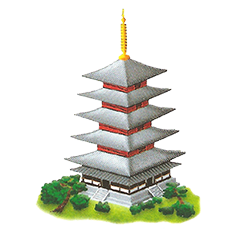 |
GOJYU-NO-TOU (five-story pagoda) t is in HOURYUJI. Hourjuyi is an area with the oldest wooden buildings in the world. Many pictures and carvings show the history of Japan for more than 1.300 years. In 1993, it was Japan first registered World Heritage Site. |
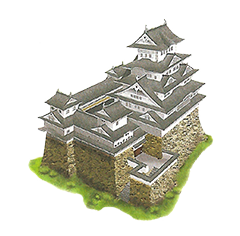 |
HIMEJIJO It is also called Shirasagijo (Egret castle). This castle comprising 83 buildings with highly developed systems of defence and ingenious protection devices dates from the beginning of the Shogun period. It is a masterpiece of contruction in wood, combining function with aesthetic appeal, and also registered a World Heritage Site in 1993. |
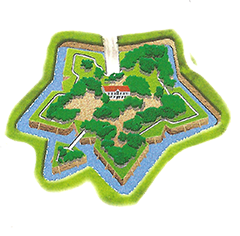 |
GORYOUKAKU It is a fort in Hokkaido and was built to protect the city of Hokodate. It is a famous place for the fight between the old government (Shogun side) and the new goverment (Imperial side) in the last stage of the Edo period. After the fort had lost its military importance, it was eventually turned into a public park in the 1910s. Over one thousand cherry trees were planted along its moats, making it one of Hokkaido's best cherry blossom spots. https://en.wikipedia.org/wiki/Goryōkaku |
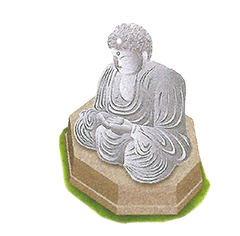 |
KAMAKURA DAIBITSU It is a Buddhist temple mainly containing one giant bronze statue of Buddha with a height of 13.35m and a weight of 121t. Monks may enter it to pray inside the statue. Its first building was made out of wood and dates from 1252. A few years later, as the wooden structure was damaged badly by a storm, it was decided to build it from Bronze. Since the big tsunami in September 20, 1488 washed all buildings away, the statue stays in the open air. https://en.wikipedia.org/wiki/Kōtoku-in |
Footnotes
For Icons explanation and licensing please visit Icons page.
- ↑
 As an alternative, the special Monasteries could simply be added to the regular tiles without removing the original cloister tiles. However, if only playing with the base game and no other expansions, this may be too many monastery tiles. (4/2014)
As an alternative, the special Monasteries could simply be added to the regular tiles without removing the original cloister tiles. However, if only playing with the base game and no other expansions, this may be too many monastery tiles. (4/2014)

